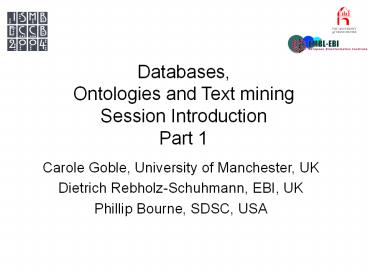Databases, Ontologies and Text mining Session Introduction Part 1 - PowerPoint PPT Presentation
Title:
Databases, Ontologies and Text mining Session Introduction Part 1
Description:
The Gene Ontology Categorizer. Joslyn, Mniszewski, Fulmer, Heaton ... Uses an event-based ontology for biological processes. Modelling levels of detail of events ... – PowerPoint PPT presentation
Number of Views:115
Avg rating:3.0/5.0
Title: Databases, Ontologies and Text mining Session Introduction Part 1
1
Databases, Ontologies and Text miningSession
IntroductionPart 1
- Carole Goble, University of Manchester, UK
- Dietrich Rebholz-Schuhmann, EBI, UK
- Phillip Bourne, SDSC, USA
2
Resources in Bioinformatics
Ontologies
The Gene Ontology
Databases
Applications and Mining
Bioinformatics
Text mining
UniProt
LocusLink
Knowledge mining
3
Resources in Bioinformatics
Ontologies
The Gene Ontology
Applications and Mining
Bioinformatics
Text mining
Knowledge mining
4
A Tower of Babel
- Interoperating resources, intelligent mining
and sharing of knowledge, be it by people or
computer systems, requires a consistent shared
understanding of what the information contained
means
Shared common controlled vocabularies Shared
common understanding of domain Formal, explicit
specification of the meaning of the terms
APPLICATION
COMMUNITY CONSENSUS
EXECUTABLE, MACHINE READABLE
5
Ontology components
- Concepts gene
- Properties of concepts and relationships between
them function of gene - Constraints or axioms on properties and concepts
oligonucleiotides lt 20 base pairs - Instances (sometimes) sulphur, trpA Gene
- Organised into directed acyclic graph
- Classifications isa, part of
BioPAX Pathway Ontology
6
Ontology classification by Borgo/PisanelliCNR-IST
C, Rome, Italy
7
Gene Ontologyhttp//www.geneontology.org
- Poster child of bio ontologies and proof of
principle - Wide adoption
- 168,000 Google hits
- International consortium
- Pioneered curation strategy
- Changes many times a day
- Developed for annotation, but used by other
applications for mining (GoMiner) - Large, legacy, inexpressive
- gt17,000 concepts
8
Six major areas of activityincreasing maturity
9
Six major areas of activity
Community collaboration, social
frameworks, methodologies Infrastructure strategy
10
Six major areas of activity
Granularity, scales, part-whole relationships,
instances, best practice rigour and formality
11
Six major areas of activity
Extended coverage New ontologies
e.g.anatomy Mapping and integration between
ontologies
12
Six major areas of activity
Database annotation, Decision support Advanced
querying Database mediation and
integration Knowledge exchange Text mining
13
Six major areas of activity
Semantic Web, W3C OWL, RDF Editing,viewing,
building Reasoning, formalising
14
Six major areas of activity
39 on OBO web site
15
The Gene Ontology CategorizerJoslyn, Mniszewski,
Fulmer, HeatonLos Alamos National Lab, Procter
Gamble
- What are the best GO terms for categorising a
list of genes? - Interprets GO as partially ordered sets
- Generate distance measures between terms
- Cluster annotated genes based on their GO terms
16
HyBrow a prototype system for computer-aided
hypothesis evaluationRacunas, Shah, Albert,
FedoroffPenn State University
- Knowledge driven tool for designing and
evaluating hypothesis - Uses an event-based ontology for biological
processes - Modelling levels of detail of events
- Tools for querying, evaluating and generating
hypothesis - A prototype yet to be fielded
17
False Annotations of Proteins Automatic
Detection via Keyword-Based ClusteringKaplan,
LinialHebrew University, Jerusalem, Israel
- How to separate the TP protein function
annotations from the FP? - Clustering of protein functional groups
- Tested on ProSite
18
Protein names precisely peeled off free
textMika, RostColumbia University, NY
- How to find mentions of protein/gene names in NL
text ? - Terminology from Swiss-Prot and TrEMBL
- 4 SVMs modelled to the task
- Assessment against e.g. BioCreAtive
19
BioCreAtive
- Task 1a Named entity tagging
- Identify each mention of a PGN within the NL text
- Input Tagged samples of PGNs
- Output correctly tagged samples of PGNs
- Obstacles correct boundary detection
- Solutions SVMs / cond. random fields / RegExp /
HMM, POS BIO tags, 1-,2-,3-grams, dictionaries,
morphology - (BioCreAtIveBlaschke/Valencia/Hirschman/Yeh,
Granada, March 2004) - Poster A-12
20
Mining Medline for Implicit Links between Dietary
Substances and DiseasesSrinivasan, LibbusNLM,
Bethesda
- How to find a (complete) set of documents related
to a given topic from Medline ? - Open Discovery Algorithm (Swanson, Smalheiser)
- Extraction of features from the text
- Iterate document retrieval based on features
- Assessment Retinal Diseases, Crohns Disease,
Spinal Chord Diseases - PubMedMatchMiner (Bussey)MedMiner
(Tanabe)MeshMap (Srinivasan)PubMatrix (Becker)
21
Online Tools _at_ ISMB
- GoPubMed, Schroeder, Biotec, TU Dresden, (A-23)
- iHop, Hoffmann, CNB, (A-61) http//www.pdg.cnb.uam
.es/hoffmann/iHOP/index.html - NLProt, Mika http//cubic.bioc.columbia.edu/servi
ces/nlprot/submit.html - ProtExt, Peng, National Taiwan University, (A-2)
- Termino, Gaizauskas, University of Sheffield,
(A-73) http//www.dcs.shef.ac.uk/ - Whatizit, Rebholz-Schuhmann, EBI, (A-72)
http//www.ebi.ac.uk/Rebholz-srv/whatizit/form.js
p
22
(No Transcript)
23
(No Transcript)
24
Gratuitous Advertising SOFG2
25
ENJOY !!































